
As of April 2024, the FPSO ONE Guyana is in transit to the Exxon’s Yellowtail field. (Source: SBM Offshore)
In the fourth and final part of Hart Energy’s 2024 Deepwater Roundup, a project-by-project summary of some of the more notable deepwater projects, takes a deep dive into deepwater developments in the Americas.
Guyana, a burgeoning power in the oil and gas industry, makes up a good portion of this list, including Payara, an Exxon Mobil-operated project in the Stabroek Block. Payara came online in November 2023 and has already reached average production rates of 220,000 bbl/d.
Exxon’s recently sanctioned Whiptail project, also in the Stabroek, looks to follow in Payara’s footsteps, with the field’s Jaguar FPSO boasting a production capacity of 250,000 bbl/d.
Petrobras’ Búzios-5 project offshore Brazil came online in 2023. Production from Búzios-6 is expected in late 2024, with other phases coming online throughout the decade. Also operated by Petrobras is Mero-2, the second phase in the multi-phase Mero project which came online in January, with other phases planned to begin producing as early as 2025.
The U.S. Gulf of Mexico (GoM) also is home to a number of projects on this list, including Chevron’s Anchor project, Beacon’s Shenandoah project and Shell’s Whale, all slated to come online in 2024. And BP’s Mad Dog Phase 2, which started production in 2023, is getting an extension.

Anchor

In October 2023, Chevron’s Anchor production platform began its journey from the Kiewit Offshore Services facility to Green Canyon Block 807, where the semisubmersible will produce 75,000 bbl/d and 28 MMcf/d of natural gas.
First oil for Anchor, a high-pressure project in 5,000 ft of water in the GoM, is expected for late 2024.
Discovered in late 2014, the field will be developed via seven subsea wells connected by a newbuild semisubmersible production unit. The project will target Wilcox-aged reservoirs that hold approximately 440 MMboe.
The $5.7 billion project will feature the first 20,000‑psi system in the GoM. In 2023, Transocean’s Deepwater Titan, an eighth-generation drillship equipped with a 20,000 psi well control system, began a contract that will keep it in the Anchor area through the second quarter of 2028.
Subsea7 handled the engineering, procurement, construction and installation (EPCI) of subsea umbilicals, risers, and flowlines, while Aker Solutions provided the project with 15 miles of 20,000 psi dynamic steel tube- and power umbilicals.
Chevron operates Anchor with a 62.86% working interest, while co-owner Total E&P USA Inc. holds the remaining 37.14%.
Bacalhau

Startup for Equinor-operated Bacalhau Field offshore Brazil has been delayed until 2025, one year later than expected, after the COVID-19 pandemic slowed work on the project.
In January the Bacalhau FPSO’s topside modules, designed by Aibel, left for Singapore where they will be integrated into the hull before heading for Brazil.
The Bacalhau Field straddles two licenses, BM-S-8 and Norte de Carcará, in 6,725 ft water depth in the Santos Basin.
Equinor made a final investment decision (FID) on the $8 billion project in 2021. The development will consist of 19 subsea wells tied back to an FPSO. The FPSO, supplied by MODEC, will have a production capacity of 220,000 bbl/d and 2 MMbbl of storage capacity, making it one of the largest FPSOs in Brazil. Oil will be offloaded to shuttle tankers and gas from Phase 1 will be re-injected in the reservoir.
Equinor is the operator for the field with a 40% ownership of the project. Partners Exxon Mobil holds a 40% stake and Petrogal Brasil a 20% stake.
Bay du Nord

Earlier this year, the Canada-Newfoundland and Labrador Offshore Petroleum Board (C-NLOPB) reported that the Cambriol G-92 discovery held 340 MMbbl of recoverable oil, bringing the reserves in the three discoveries that will make up the Bay du Nord development to 1.13 Bbbl.
Located in the Flemish Pass Basin, Equinor’s $12 billion project sits in 3,838 ft of water offshore Newfoundland. Once completed, Bay du Nord will be the first deepwater production site offshore Canada. The development is expected to involve a 40-well subsea production system tied back to a large FPSO.
After receiving federal environmental approval in 2022, Equinor decided in May 2023 to delay sanction on the project for three years in an effort to lower project costs.
KBR performed pre-FEED work on the Bay Du Nord project and will further develop the engineering and execution planning. KBR also signed a letter of intent for the topside facilities FEED for the new Bay Du Nord FPSO.
Equinor is the operator of the project with a 60% ownership stake. BP is a partner in the field with a 40% stake.
Búzios
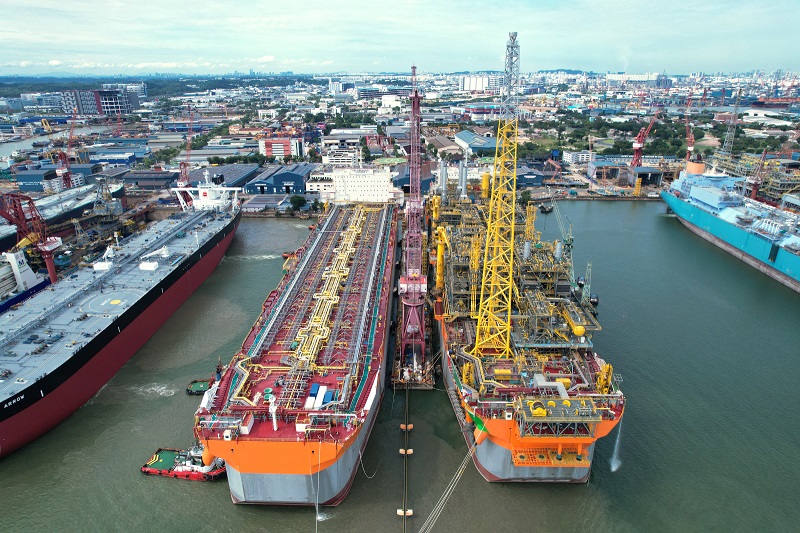
In June 2023, the fifth of 11 planned FPSOs for the Petrobras-operated Búzios Field came online offshore Brazil.
Búzios-5, which sits in 6,234 ft of water, has five production and five injector wells, producing up to 150,000 bbl/d of crude, 6 MMcm/d of natural gas and 220,000 bbl/d of water injection. The P-74, P-75, P-76 and P-77 FPSOs in the Búzios, the world’s largest deepwater field, are jointly producing 600,000 bbl/d.
Discovered in 2010, the massive Búzios Field entered production in 2018 with the P-74 FPSO. Due to the size of the field, a total of 11 FPSOs are planned for development.
Búzios-6, located in 6,890 ft of water, is expected to come into production later this year via SBM Offshore’s FPSO Almirante Tamandaré. The FPSO will have a processing capacity of 225,000 bbl/d and 12 MMcm/d.
The Búzios-6 development will involve approximately 15 wells, an FPSO and subsea trees. Production is expected to begin in the second half of 2024. The field is expected to recover 885 MMboe.
In February, Baker Hughes secured a contract for integrated well construction services in the Búzios Field, set to begin in 2025. Services will include drilling services, drill bits, wireline, cementing, wellbore clean up, fishing, remedial tools, fluids, services and geosciences. In July 2023, Vallourec won a contract to supply the field with corrosion-resistant alloy cladding pipelines.
The FPSO Almirante Tamandaré will be operated by SBM Offshore with 55% ownership. Mitsubishi will have a 25% stake in the FPSO, and Nippon Yusen Kabushiki Kaisha will hold the 20% interest.
OneSubsea has already begun delivering trees for Búzios-7 and Búzios-8. TechnipFMC will supply subsea trees with controls, electrical and hydraulic distribution units, topside systems and installation and intervention support services with rental tooling. Vallourec will also supply pipelines for the two projects.
Petrobras is the operator of the Búzios Field with a 92.6% stake, with partners CNOOC and CNODC each holding a 3.7% interest.
Mad Dog Phase 2, Extension

In January, BP contracted TechnipFMC to install pipe and umbilicals for the Argos Southwest Extension of the Mad Dog Phase 2 project.
The extension project will tie back three new wells to the BP-operated Argos production semisubmersible in the U.S. GoM, which is the second production facility serving the larger Mad Dog project.
Named Argos after Odysseus’ loyal dog from Homer’s "The Odyssey," getting the $9 billion project onstream was a journey. After a series of delays related to design, pricing and the COVID-19 pandemic, Phase 2 of the Mad Dog project began production in April 2023.
The platform — BP’s fifth platform in the GoM — is moored in 4,500 ft of water in Green Canyon Block 780. It has a nameplate capacity of 140,000 bbl/d of oil from up to 14 production wells and water injection capacity of 140,000 bbl/d through eight injectors.
The Argos production semi is 6 miles away from the Mad Dog spar that started production in 2005.
BP operates the Mad Dog Field with 60.5% interest on behalf of Woodside Energy with 23.9% and Chevron affiliate Union Oil Company of California with 15.6%
Mero
The second phase of Petrobras’ Mero project came online offshore Brazil in January, with additional phases expected to start up by 2025.
Located in the Libra Block, 112 miles off the coast of Rio de Janeiro in the presalt Santos Basin, the project lies in water depths of 5,900 ft to 7,200 ft.
Sanctioned in 2019, Mero-2 produces to the FPSO Sepetiba, which has an operational capacity of 180,000 bbl/d of oil and 12 MMcm/d of natural gas. Sepetiba serves 16 development wells, including eight producer wells and eight water and gas injection wells.
Mero-2’s output brings Mero Field production to an average 410,000 bbl/d of oil.
The Mero-3 and Mero-4 development phases are expected to produce 180,000 bbl/d of oil each. Both are currently under construction.
Production from the third phase of the Mero development is expected to start through MISC Berhad’s FPSO Marechal Duque de Caxias in 2025. The Mero-3 FPSO will link with eight oil producers and seven water and gas injectors. The wells will be connected using subsea infrastructure consisting of fixed production and injection ducts, control umbilicals and flexible service ducts.
Petrobras awarded TechnipFMC an integrated EPCI contract for a subsea high-pressure separation process for the Mero-3 in January. The contract covers the design, engineering, manufacture and installation of manifolds, flexible and rigid pipes, umbilicals and power distribution and life of field services.
For Mero-4, Subsea7 will handle engineering, procurement, fabrication, installation and pre-commissioning of 47 miles of rigid risers and flowlines for the steel lazy wave production system. Tenaris was awarded a contract to provide coating services for the Mero-4.
Petrobras is the operator of the field, with a 38.6% stake. TotalEnergies and Shell Brasil each hold a 19.3% stake in the field; CNPC and CNOOC each have a 9.65% stake in the field; and Pré-Sal Petróleo S.A (PPSA) holds the remaining 3.5%.
Parque das Baleias

Petrobras’ fourth FPSO is expected to begin production in the Parque das Baleias (Whale Park) project offshore Brazil late this year.
In August 2023, Yinson Production secured a $230 million term loan facility for the Maria Quitéria FPSO, which will be deployed at Parque das Baleias.
The unit, which will be able to process 100,000 bbl/d of oil and 177 MMcf/d of natural gas from the Jubarte Field, is due to start operation in the Campos Basin in 2024.
The Parque das Baleias project is made up of seven fields, which combined hold more than 2 Bboe of recoverable reserves. They are the Jubarte, Baleia Azul, Baleia Franca, Baleia Anã, Cachalote, Caxaréu and Pirambú fields.
The project calls for connecting 17 wells to the Maria Quiteria FPSO, with nine being oil producers and eight being water injectors using subsea infrastructure of flexible pipelines, electro-hydraulic umbilicals and Christmas trees.
Currently, three platforms are in operation: P-57, P-58 and the Cidade de Anchieta FPSO.
FPSO P-57 began operating on the Jubarte Field in December 2010. The FPSO Cidade de Anchieta, in connection with the Baleia Azul, Jubarte and the Pirambu fields, commenced production in September 2012. The FPSO P-58 is connected to the Baleia Franca, Cachalote, Jubarte, Baleia Azul and Baleia Anã fields and receives oil from 19 satellite wells. It started operation in March 2014.
Petrobras is the sole owner and operator of Parque das Baleias.
Payara
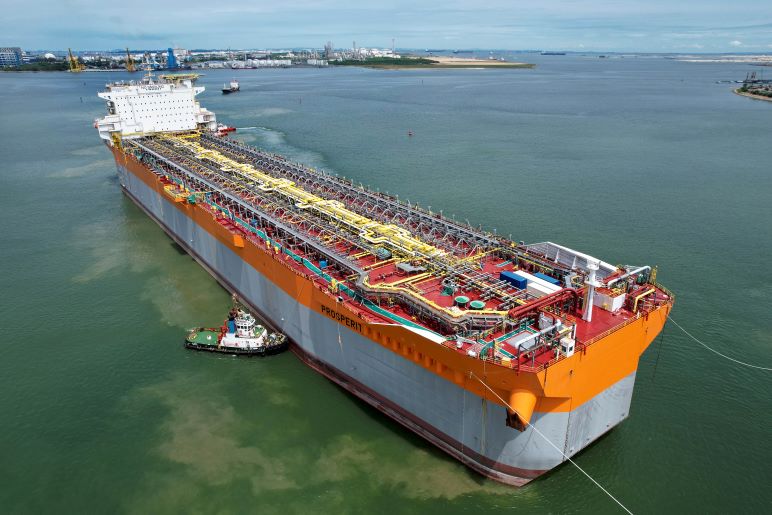
In February, less than three months after coming online, the Exxon Mobil-operated Payara project offshore Guyana reached 220,000 bbl/d in production.
SBM Offshore’s Prosperity FPSO arrived in the Stabroek Block in April 2023. Prosperity, moored in around 6,000 ft of water, has a production capacity of 220,000 bbl/d of oil, with gas treatment of 400 MMcf/d and water injection of 250,000 bbl/d. Overall, the FPSO has storage capacity of about 2 MMbbl.
FID on the $9 billion development was reached in 2020. The project targets an estimated resource base of about 600 MMboe. Exxon Mobil and Hess, working with China’s CNOOC Ltd., are planning 10 drill centers for up to 20 production and 21 injection wells.
TechnipFMC and Halliburton provided fiber optics for Payara. TechnipFMC provided optical connectivity from the topside to the completions while Halliburton handled the fiber optic sensing technology and analysis to support reservoir diagnostics. TechnipFMC manufactured and delivered the subsea production system for Payara.
Exxon Mobil is the operator of the field with a 45% ownership stake. Hess has a 30% stake and CNOOC a 25% stake.
Salamanca
The LLOG-operated Salamanca project in the U.S. GoM is expected to begin producing in mid-2025 to the decommissioned and refurbished Independence Hub platform.
Salamanca will receive production from the Leon and Castille discoveries in Keathley Canyon Blocks 642 and 736, respectively. Repsol drilled the Leon discovery in late 2014 in 6,000 ft of water and the Castile discovery in more than 6,500 ft of water.
In March, LLOG Exploration awarded ABL a contract for marine warranty survey services for the subsea development.
LLOG awarded Subsea7 a contract in May 2023 to install oil and gas export pipelines that depart from the Salamanca semisubmersible and tie into existing pipeline transport systems.
Trendsetter Engineering will provide subsea hardware, including the subsea production manifold. Trendsetter is also supplying TCS connectors and ATV valves for the export tie-ins. The equipment is slated for delivery in early 2024.
The deepwater development project will initially involve three subsea wells to achieve production from the two fields. Two of the three development wells will be drilled at the Leon Field, while the third will be drilled at the Castile Field.
The project will be developed using the previously decommissioned Independence Hub semisubmersible. LLOG purchased the platform in 2022 and plans to refurbish with a capacity of 60,000 bbl/d of oil and 40 MMcf/d of natural gas. The production facility will be moored in Keathley Canyon Block 689 in a water depth of 6,400 ft.
LLOG is the operator with partners Repsol and Beacon Offshore Energy.
Sergipe
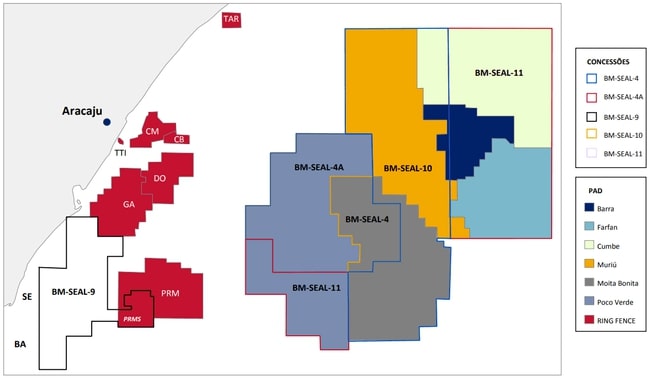
In February, Petrobras extended the bid proposals deadline for two FPSOs for its Sergipe Deepwater Project (SEAP) in the Sergipe-Alagoas Basin offshore Brazil. The deadline was extended from February 19 to June 14 for the pair of FPSOs to be deployed at the SEAP-I and SEAP-II projects.
The SEAP-1 FPSO, which is expected to begin production in 2026, will have capacity for 120,000 bbl/d of oil and 10 MMcm/d of natural gas and serve the Agulhinha, Agulhinha Oeste, Cavala and Palombeta fields in the BM-SEAL-10 and BM-SEAL-11 concessions. Petrobras operates BM-SEAL-10 with 100% interest and BM-SEAL-11 with 60% interest. IBV Brasil Petróleo Ltda. holds the remaining 40% interest.
The SEAP-2 FPSO, which is likely to begin production in or after 2026, will have capacity for 120,000 bbl/d of oil and 12 MMcm/d of gas and serve the Budião, Budião Noroeste and Budião Sudeste fields in the BM-SEAL-4, BM-SEAL-4A and BM-SEAL-10 concessions. Petrobras operates BM-SEAL-4 with 75% interest on behalf of ONGC Campos Ltda. with 25%. Petrobras operates BM-SEAL-4A and BM-SEAL-10 with 100% interest.
The FPSOs will be moored in water depths of 8,200 ft to 9,800 ft.
In addition, the developments will have an 83-mile long gas pipeline, of which 69 miles will be at sea and 14 miles on land.
While Petrobras has declined to provide a volume estimate, market analysts have said the region contains about 1.2 Bbbl of recoverable reserves.
Shenandoah

Beacon Offshore Energy’s operated Shenandoah project in the U.S. GoM is scheduled to come online in late 2024.
In April, the company divested non-operating stakes in several fields in order to concentrate its portfolio on key developments like Shenandoah.
In January, Gate Energy secured a contract for the final pre-commissioning, commissioning, planning and execution for the Shenandoah floating production and storage vessel, which has sailed away from South Korea.
Shenandoah is in a high pressure/high temperature environment in Walker Ridge blocks 51, 52 and 53. The project will be developed by a semisubmersible in 5,900 ft of water. Multiple wells are expected to develop an estimated 100 MMbbl to 400 MMbbl of reserves, targeting previously discovered reservoirs in the Upper and Lower Wilcox.
Transocean was awarded a two-phase drilling contract for the project. The Deepwater Atlas drillship — the world’s first eighth gen ultra deepwater drillship — completed the first phase of the contract in July 2023. Phase one was drilled using dual BOPs rated to 15,000 psi. Phase 2, which began in October and will run until July 2024, will use 20,000-psi BOPs for the completion activities.
The project is owned and operated by Beacon, who holds a 31% working interest in the field, after acquiring ownership and operatorship from LLOG in 2020. ShenHai (49%) and HEQ (20%) are the other interest holders in the project.
Trion

In August 2023, Mexico regulator Comision Nacional de Hidrocarburos approved Woodside Energy’s development plan for the Trion project in the GoM, expected to come online in 2025.
In 2022, rising costs for manufacturing components on mega projects forced Woodside back to the drawing board. Woodside delayed FID on the $11 billion project as designed. In June 2023, Woodside took FID on a revised $7.2 billion plan to develop Trion.
Related: Woodside Brings in the Know-how
Woodside Energy awarded Subsea7 a contract valued at between $300 million and $500 million to provide subsea installation services for Trion.
Discovered in Mexico’s Perdido Fold Belt in 2012, Trion is a greenfield development reservoir that holds more than 1 Bboe. The field is about 20 miles south of the U.S. and Mexico maritime border at a water depth of 8,200 ft.
Trion will be developed with a semisubmersible capable of producing and transferring 100,000 bbl/d to a floating storage and offloading (FSO) vessel. Oil from the FSO is expected to be exported to the market, with excess gas transferred back via a pipeline to existing offshore gas export infrastructure. The plan includes phased development drilling with 24 total wells.
Trendsetter Engineering was awarded a contract to provide several subsea manifolds to support Trion. Wood will engineer topsides for the project. Wood won the topsides detailed engineering contract from HD Hyundai Heavy Industries, the engineering, procurement and construction provider for the FSO. TechnipFMC provided infield flowlines and jumpers.
Woodside gained control of Trion through its acquisition of BHP Petroleum. Woodside operates the field and holds a 60% participating interest. PEMEX Exploration & Production Mexico owns the remaining 40%.
Uaru

Following Exxon Mobil’s April 2023 FID of the $12.7 billion Uaru project offshore Guyana, the development remains on track to start production in 2026.
The Uaru project calls for up to 10 drill centers and 44 production and injection wells to develop an estimated resource of more than 800 MMbbl of oil.
Uaru will be the supermajor’s fifth deep-water development in the Stabroek Block, with first oil expected in the fourth quarter of 2026. The project is in water depths of 6,560 ft and encompasses the Mako and Snoek finds in the area.
In January, MODEC awarded Jumbo Offshore a contract to pre-install the mooring spread for the Errea Wittu FPSO for Uaru. ABB won the contract to deliver a complete electrical system and associated digital solutions to the Errea Wittu FPSO.
The Errea Wittu FPSO will combine the development of the Snoek, Mako and Uaru resources in the Stabroek Block. The FPSO will have oil storage capacity of 2 MMbbl with capacity to process 250,000 bbl/d of oil and 540 MMcf/d of natural gas. The FPSO will be able to offload approximately 1 MMbbl onto a tanker over approximately 24 hours.
TechnipFMC won a contract to supply Uaru’s subsea system in May 2023. The award covers 44 subsea trees and associated tooling as well as 12 manifolds and associated controls and tie-in equipment. The scope covers project management, engineering and manufacturing to deliver the overall subsea production system.
Saipem was awarded a contract to design, fabricate and install subsea structures, risers, flowlines and umbilicals for the subsea production facility.
Exxon Mobil controls a 45% operating stake in the project. Hess holds 30%, and CNOOC 25%.
Whale
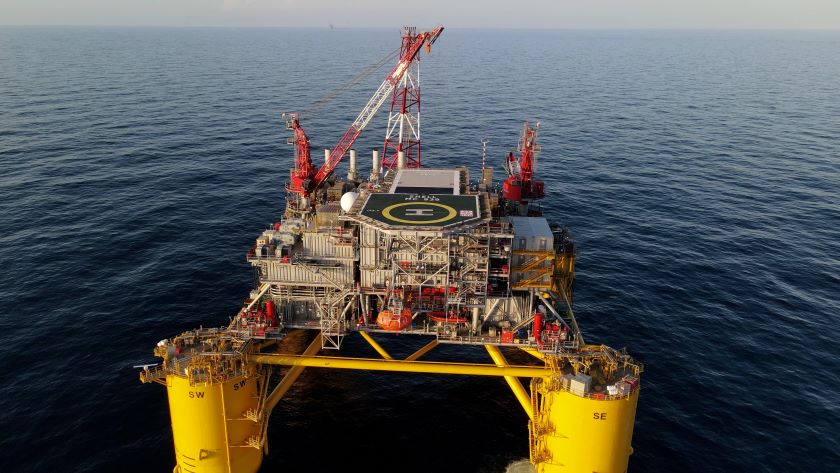
In November, the Boka Vanguard, Boskalis’ heavy transport vessel, brought the semisubmersible for Shell’s Whale project to Ingleside, Texas. That’s the semisubmersible’s last stop before heading to the GoM’s Alaminos Canyon, where first production is expected later this year.
Seatrium said in October it completed fabrication and integration of topsides, living quarters and hull for the unit. The semisubmersible features a 99% replicated hull and an 80% replication of the topsides from Shell’s Vito project, with a topside module and a four-column semisubmersible floating hull. By leveraging the engineering, construction and supply chain of Vito, Whale is expected to achieve first oil only 7.5 years after discovery, according to Shell. Shell sanctioned the project in 2021.
Discovered in 2017 in Alaminos Canyon Block 773, the Whale semi-submersible production host will be moored in 8,600 ft of water and serve 15 oil producing wells. The field currently has an estimated recoverable resource volume of 490 MMboe with expected peak output of around 100,000 boe/d.
Shell operates Whale with 60% interest on behalf of Chevron with 40%.
Whiptail
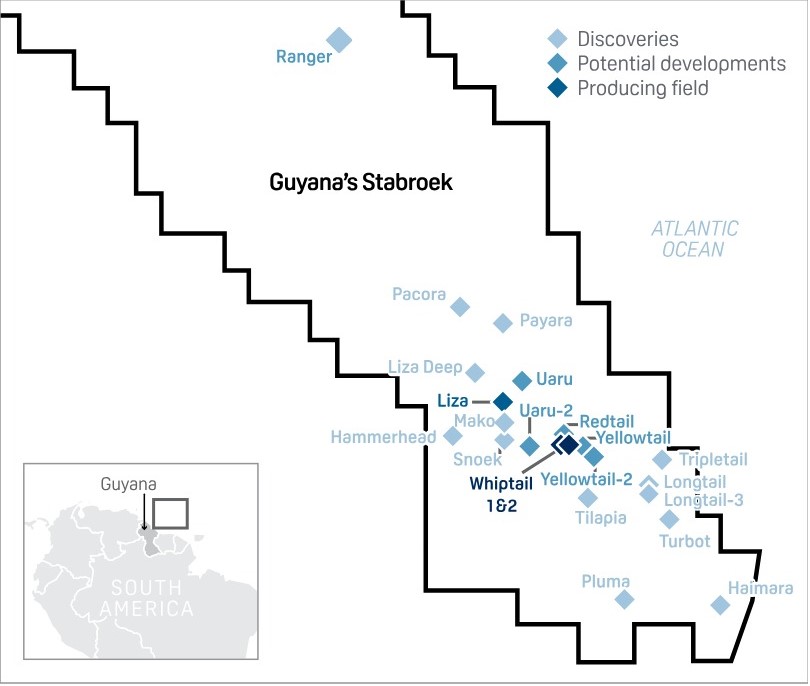
Exxon Mobil sanctioned its sixth deepwater project in the Stabroek Block, the Whiptail development, in April.
The $12.7 billion project offshore Guyana sits in approximately 6,000 ft of water and is expected to begin production in 2027. Whiptail’s plan for development will target a resource base of more than 850 MMbbl of oil and include up to 10 drill centers and 48 production and injection wells.
Related: Exxon Ups Mammoth Offshore Guyana Production by Another 100,000 bbl/d
Whiptail production will flow to SBM Offshore’s Jaguar FPSO, which is under construction. The Jaguar FPSO will have capacity to produce 250,000 bbl/d, treat 540 MMcf/d of associated gas, inject 300,000 bbl/d of water and store 2 MMbbl of crude oil.
In November, Saipem won an EPCI contract for the project. Saipem’s FDS2, Constellation and Casterone vessels will handle the design, fabrication and installation of subsea structures, risers, flowlines and umbilicals for the Jaguar FPSO. Saipem also won another contract for the EPCI of the subsea production facility.
TechnipFMC won a large contract to supply subsea production systems for the Whiptail project. The technology provider will supply project management, engineering and manufacturing services to deliver 48 subsea trees, 12 manifolds and associated equipment.
ExxonMobil Guyana awarded Strohm a jumper on demand contract for thermoplastic composite pipes for Whiptail. The 24 jumpers, made of carbon fiber and PA12 polymer, will be installed at water depths over 5,250 ft and operate in pressures of 10,000 psi.
Exxon Mobil affiliate ExxonMobil Guyana Ltd. operates the 6.6-million-acre Stabroek Block with 45% interest on behalf of partners Hess Guyana Exploration Ltd. with 30% interest and CNOOC Petroleum Guyana Ltd. with 25% interest.
Yellowtail
SBM Offshore’s FPSO ONE Guyana, built for Exxon Mobil’s Yellowtail field offshore Guyana, has left drydock and arrived at the Seatrium yard in Singapore. Three topsides modules for the vessel, completed at SBM’s JV partner yard QMW in China, were in transit as of April 2024 and will be installed quayside.
In 2022, Exxon Mobil tapped SBM Offshore for this fourth FPSO for Guyana operations. It will have a production capacity of approximately 250,000 bbl/d, with first production expected in 2025. The FPSO will have associated gas treatment capacity of 450 MMcf/d and water injection capacity of 300,000 bbl/d. The vessels will have storage capacity of approximately 2 MMbbl of crude oil.
After receiving approval from the Guyanese Environmental Protection Agency, Exxon Mobil reached FID on the $10 billion Yellowtail project in April 2022. Yellowtail, in 6,046 ft of water, has an estimated resource of more than 900 MMbbl. Production is slated to begin in 2025. The project will include six drill centers and up to 26 production and 25 injection wells.
Related: Chevron-Hess Deal Creates American “Dream Team” Offshore Guyana, Surprises Analysts
TechnipFMC provided project management, engineering, manufacturing, and testing capabilities for the subsea production system, which includes 51 enhanced vertical deepwater trees,12 manifolds and associated controls and tie-in equipment.
Exxon Mobil subsidiary Esso Exploration & Production Guyana Ltd. is operator and holds 45% interest in Stabroek Block. Hess Guyana Exploration Ltd. holds 30% interest and CNOOC Petroleum Guyana Ltd. holds 25% interest.
Recommended Reading
US Drillers Cut Oil, Gas Rigs for Third Week in a Row, Baker Hughes Says
2024-08-30 - The rig count is 8% below this time last year, according to Baker Hughes.
Helix Awarded Vessel Service, Charter Contracts Off Brazil
2024-08-28 - Helix Energy Solutions Group was awarded new three-year charter and service contracts, valued at an estimated $786 million, from Petrobras for Siem Helix 1 and Siem Helix 2.
Shell, Akselos Enter Enterprise Deal for Structural Performance Management
2024-08-28 - Shell Information Technology International will leverage Akselos’ structural performance management software to monitor the health and lifecycle of Shell’s critical assets in Qatar, Canada, the Gulf of Mexico and elsewhere.
From Exxon to APA, E&Ps Feel Need to Scratch Exploration Itch
2024-08-27 - Exxon Mobil is looking for its “next Permian,” which an executive said could be in Algeria.
E&P Highlights: Aug. 26, 2024
2024-08-26 - Here’s a roundup of the latest E&P headlines, with Ovintiv considering selling its Uinta assets and drilling operations beginning at the Anchois project offshore Morocco.





